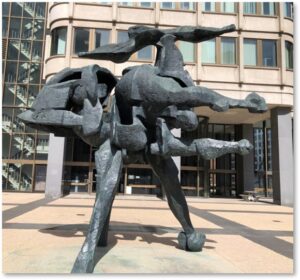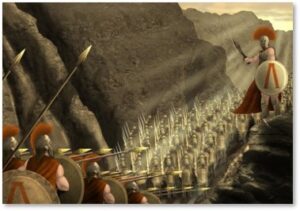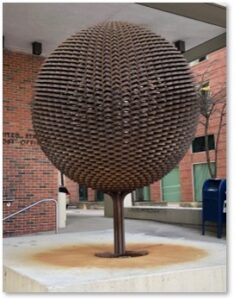Although I have written a lot about Boston artworks that are hiding in plain sight, I have so far dealt mostly with murals. The city also boasts many sculptures, however, some attributed to the artist, but others stand lonely and unidentified. This post focuses on two statues that grace Government Center, both abstract. Many more remain, however; too many for any one blog post. I will write about some of them in the future.
Thermopylae (1966)
We find this sculpture on City Hall Plaza along the south side of the John F. Kennedy Federal Building, not far from Cambridge Street and the Sol LeWitt Mural. “Thermopylae” by Dimitri Hadzi, stands 16 feet high and weighs in at 2 ½ tons. It has a massive presence yet somehow doesn’t dominate the area.
The plaque states that it was “inspired by ‘Profiles in Courage’ and the brilliant war record of President John F. Kennedy.” Marty Carlock’s “A Guide to Public Art in Greater Boston” says it reflects Mr. Hadzi’s interest in classical armor, history, and myth, stemming from his Greek heritage and his years working in Greece and Rome. The two explanations connect different warriors in far distant times.
The Battle of Thermopylae
The sculptor named this statue after the Greek battle (480 BC where the Spartans, led by King Leonidas defended a narrow pass against the southward-advancing Persian army. They held their own against the Persian king Xerxes I and his vastly greater army for three days. Then a Greek citizen seeking a reward betrayed the Spartans, which allowed the Persians to outflank them.
Sending the main army into retreat, Leonidas stayed with a small contingent that remained to hold the narrow pass. In a display of great courage, the Spartans fought the Persians to the last man. Today we celebrate the Battle of Thermopylae as an example of heroic persistence against seemingly impossible odds.
The Sculpture’s Abstract Shape
Mr. Hadzi described his sculpture as,
“Thoroughly symbolic in its abstract shapes, basically organic in form, heavy forms contrast with thin, solid with open, vertical with horizontal, and round with angular. Through the effect of the sun, rain, and snow on the sculpture, the viewer is provided with ever-changing visual and emotional experiences.”
The sculpture’s shadow also makes some interesting shapes on Government Center’s pavement.
Large, dynamic and assertive, “Thermopylae” looks to me like one of the figures from Picasso’s “Guernica” that leapt off the canvas and was frozen here in bronze. Although one artist worked in paint and the other in bronze, both men found their inspiration in war.
Computersphere (1965-1967)
Not far from “Thermopylae in distance but centuries later in time, we find “Computersphere” outside the Government Center Post Office at 25 New Chardon Street.
Done by Alfred M. Duca (see recent post on “Boston Tapestry”), this work stands alone without any plaque that I could find to identify it. Executed in Cor-ten steel, the sphere has a diameter of eight feet and stands on a metal column.
Mr. Duca believed that “Computersphere” may have been the first work done from a computer-generated design. If so, it deserves better placement in a location where it can be appreciated by more people.
U.S. Steel trademarked Cor-ten™ as the name for a group of steel alloys the company developed to eliminate the need for painting. It forms a stable rust-like appearance after several years’ exposure to weather. You can see the success of the weathering process in the circular rust marks on the concrete plinth beneath the sculpture.
Hunting Boston’s Missing Statues
Given the propensity of Boston’s statues to change locations, sometimes disappearing overnight, I thought it would be a good idea to document some of them. Currently, two of Boston’s missing statues, one large and one small, that seem to have vanished from their original locations and I am chasing them down.
I don’t know whether they have been moved like Helion (the giant lollipops) or Quest Eternal (the naked guy), crated up and stored like State Street Bank’s four N.C. Wyeth murals, or sold out of the city. I’ll keep you posted if I find them.




